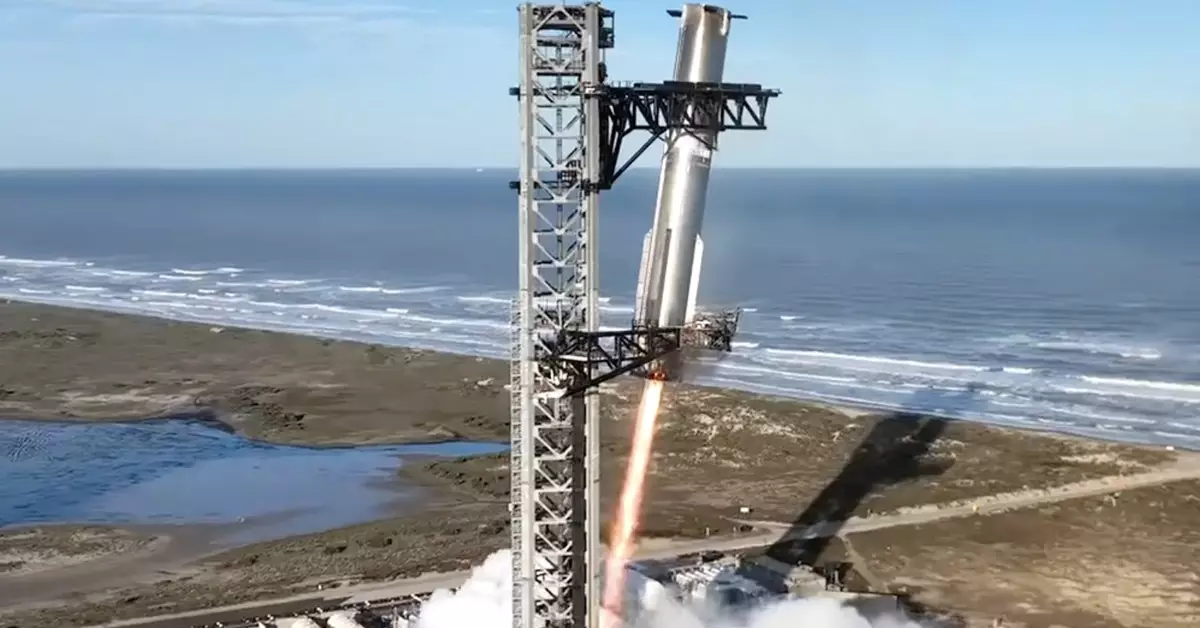The ever-ambitious SpaceX continues to capture the world’s attention with its groundbreaking endeavors in space exploration. Recently, the company achieved a significant milestone when it successfully caught its Super Heavy booster for the second time during Starship’s seventh test flight. However, while this accomplishment was celebrated, the mission also experienced setbacks that raised questions about the vehicle’s reliability and future potential.
During the test flight from the Boca Chica launch facility in Texas, spectators were treated to a rare event as the Super Heavy booster descended and was ensnared by the launch tower’s “chopstick” arms. This innovative strategy signifies not just a leap in SpaceX’s reusability mission but also marks a step forward in making space travel more efficient and sustainable. The concept of reusing booster rockets could dramatically reduce the cost of access to space, making it more feasible for commercial ventures and public space initiatives alike.
Despite the success of the catch, the Starship spacecraft—now mounted atop the booster—failed to maintain communication during ascent, leading to a breakdown of the mission’s objectives. Kate Tice, a representative from SpaceX, provided a grim update, indicating that while the spacecraft had detached successfully, it encountered problems that ultimately resulted in the loss of the ship. This communication failure underscores the complexities involved in such ambitious projects, where even minor setbacks can result in profound consequences.
One of the more intriguing aspects of this flight was SpaceX’s attempt to enhance the performance and reliability of Starship. This iteration featured crucial upgrades, such as a redesigned propulsion system and an advanced flight computer, alongside an innovative heat shield designed to test multiple materials. Additionally, SpaceX was experimenting with a backup layer intended to protect against damage to tiles—an essential feature for the spacecraft’s thermal protection during re-entry.
However, despite these upgrades, the mission faced a “rapid unscheduled disassembly” during its ascent burn. The term itself reflects a somewhat tongue-in-cheek way of describing catastrophic failure, but it leaves stakeholders questioning the robustness of the testing protocols. Was the reduction of tiles meant to stress-test vulnerable areas a factor in this breakdown? Such queries must be addressed if SpaceX is to ensure the reliability expected from such advanced technology.
Public Perception and User Engagement
Public interest in SpaceX’s ventures, especially Starship, has continued to grow, with social media playing a significant role in the dissemination of information. Witnesses from the Turks and Caicos islands reported seeing debris from the Starship’s re-entry, and footage of the incident quickly spread across various platforms. This engagement not only shows the power of live coverage but also highlights a connection to an audience that is fascinated by both the successes and failures of such monumental projects.
As the narrative of space exploration evolves, the public is no longer just an observer but a participant in the story. The real-time updates and visuals shared by onlookers reinforce the excitement of progress while maintaining a balanced view of the risks involved. Yet, this immediacy can also amplify negative perceptions, raising concerns about safety and efficacy.
Looking towards the future, it is crucial for SpaceX to reflect on the lessons learned from this latest flight. The company’s eagerness to innovate and push boundaries must be tempered with a profound understanding of the risks involved in developing such groundbreaking technology. Each test—successful or otherwise—provides data that can pave the way for enhancements and improvements, but it is essential to carefully examine each area of failure to guarantee the continued advancement of space travel.
SpaceX’s journey with the Starship program illustrates the dual nature of innovation: achievement and adversity often go hand-in-hand. As the company continues to strive for excellence in its ambitious goals, ensuring robustness and reliability must remain paramount. The implications of these tests extend beyond technological capabilities, influencing the future of space exploration, commercial ventures, and humanity’s journey into the cosmos.


Leave a Reply